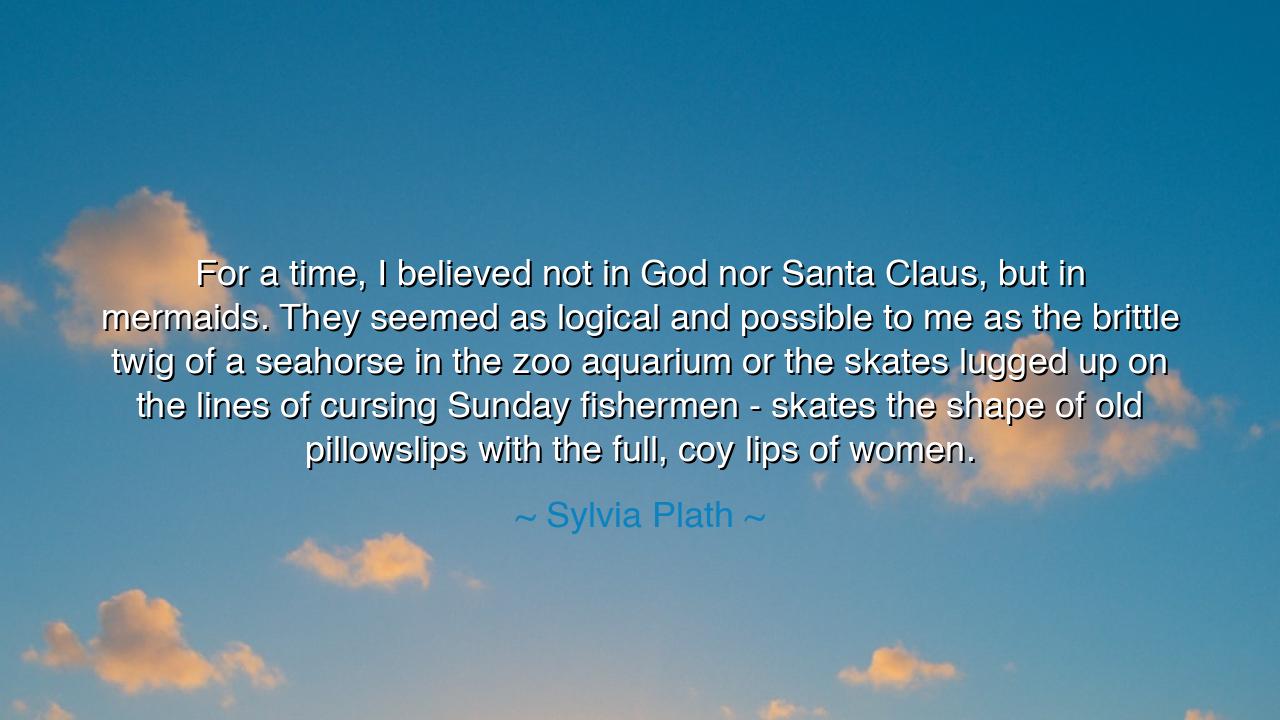
For a time, I believed not in God nor Santa Claus, but in
For a time, I believed not in God nor Santa Claus, but in mermaids. They seemed as logical and possible to me as the brittle twig of a seahorse in the zoo aquarium or the skates lugged up on the lines of cursing Sunday fishermen - skates the shape of old pillowslips with the full, coy lips of women.






Sylvia Plath, poet of fire and shadow, once confessed with haunting candor: “For a time, I believed not in God nor Santa Claus, but in mermaids. They seemed as logical and possible to me as the brittle twig of a seahorse in the zoo aquarium or the skates lugged up on the lines of cursing Sunday fishermen—skates the shape of old pillowslips with the full, coy lips of women.” In these words, she unveils the strange mingling of childhood wonder and sharp perception, where the fantastic seemed no less real than the creatures of the sea itself. Her belief in mermaids was not mere whimsy, but the child’s insistence that myth and reality often touch hands.
The origin of this reflection lies in Plath’s own youth, where the boundary between imagination and reality was porous, and the world shimmered with enchantment. Unlike many who grew out of their fancies into cold disbelief, Plath chose to honor the possibility of the mythical. The mermaid, half-human and half-sea, represented for her a bridge between the real and the dreamt, the ordinary and the uncanny. To her child’s eyes, they seemed no less plausible than the grotesque yet wondrous skates caught by fishermen or the delicate, alien beauty of a seahorse.
History too bears witness to this mingling of myth and nature. Sailors of old, weary at sea, mistook manatees and other sea creatures for mermaids, weaving tales that blurred reality and fantasy. These stories were not lies but human attempts to shape mystery into form. So too Plath’s belief reflects this ancient impulse: to find in the strange forms of life—creatures that already defy expectation—the seed of legends. Myth thus emerges not as falsehood, but as another way of seeing truth.
Her words also hint at a deeper truth of the human heart: that belief is not always about what is proven, but what gives shape to wonder. God and Santa Claus represented systems of belief imposed upon her; the mermaid, however, was her own chosen mystery, a belief rooted in direct observation of a world both enchanting and strange. By choosing mermaids, she chose imagination over doctrine, perception over dogma, and wonder over certainty.
Therefore, O seekers of wisdom, let us learn from her confession. Mermaids are not merely fanciful creatures of the sea; they are symbols of humanity’s eternal hunger to find wonder where reason falls silent. To believe in them, even for a moment, is to honor the child’s vision that sees the miraculous hidden within the mundane. For life itself is a sea, and those who dare to imagine will always glimpse the shining tail just beneath the waves.






NAThai Ngoc Anh
Sylvia Plath’s depiction of belief in mermaids as being as real as sea creatures or fishermen’s catches speaks to the way the mind works when grappling with the unknown. The reference to 'the full, coy lips of women' adds a layer of complexity, suggesting that perhaps mermaids, like other myths, are linked to gender and the mysteries of womanhood. What is it about mythological creatures like mermaids that continue to captivate our imaginations even as we grow older?
TTNguyen Pham Thao Trang
This quote makes me think about the strange mix of reality and fantasy in childhood. Mermaids, to me, seem like a perfect example of how the mind tries to make sense of the world by blending the fantastical with the real. The way Plath describes them through the lens of ordinary things like skates or sea creatures adds to their allure. Is this quote simply about childhood imagination, or could it be a deeper commentary on the human need to believe in something beyond what we can see?
VANg van anh
I really like how Plath uses such strong visual imagery to convey the feeling of belief in something magical, even when it’s not quite tangible. The idea of mermaids being just as possible as a seahorse or a fisherman’s catch speaks to the innocence and curiosity that children possess. But it also brings to mind the deeper question: are we ever really ready to let go of those magical beliefs, or do they evolve into something else as we grow older?
DTMy Dang Thao
This quote strikes me as a unique reflection on how we attach significance to things that are not necessarily real but seem plausible at the time. Plath’s reference to mermaids and the imagery of skates as 'old pillowslips with the full, coy lips of women' is vivid, but what does it mean about the way we project meaning onto the unknown? I wonder if this was Plath’s way of showing how our beliefs often arise from the mysteries and contradictions of life.
LNly nguyen
Sylvia Plath’s quote beautifully captures the whimsical and strange nature of childhood imagination. Mermaids, like other fantastical creatures, become real to children through their vivid, imaginative experiences. The way she links mermaids to things like sea creatures or fishermen’s catches is so evocative. I wonder, though, how much of this quote reflects Plath's own search for meaning or something more profound during a turbulent time in her life. Could mermaids be a metaphor for ungraspable desires?